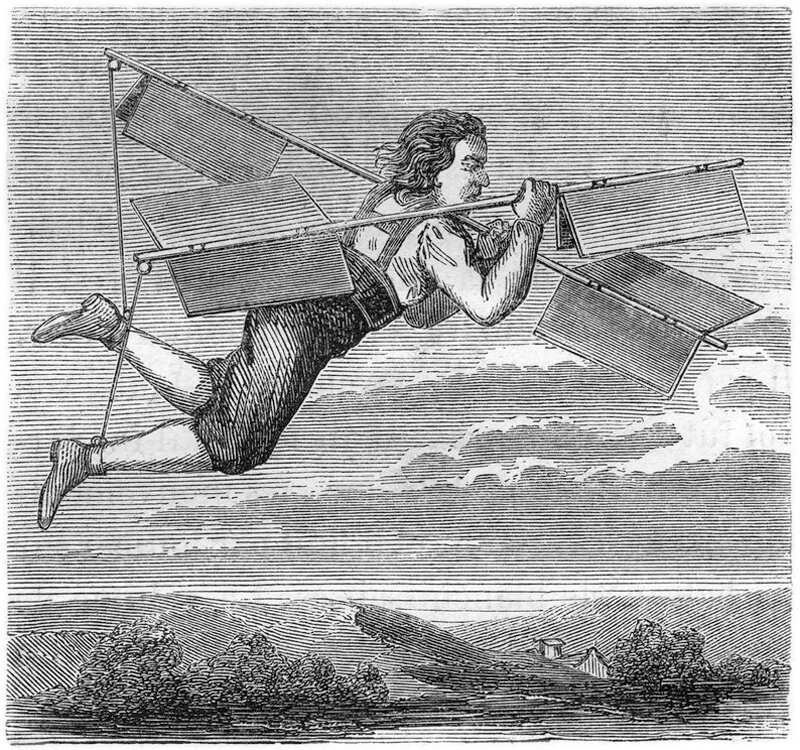Besnier's Flying Apparatus
An illustration of Besnier flying above the countryside with his flying apparatus. Drawing from Les Merveilles de la Science, circa 1870.
Many early attempts at flight were taken by people who had no formal background in the subject. Pictured above is Besnier, a locksmith from Sablé, France. In the 1670’s, Besnier had become obsessed with flight, and sometime around 1678 he built and tested an apparatus to mimic the beating of a bird’s wings. His invention was rather simple. It consisted of two wooden rods, each balanced on one of his shoulders. One end of each rod was tied to one of his feet with string, while the other end was held by his hand. At both ends of each rod were a pair of taffeta flaps that would spread out to catch the air when pulled down, and close up when pulled up. Then, in an alternating fashion, he would pull down with one arm and the opposite leg, then pull down with the other arm and leg, and so on. When it was working, the movements resembled a person walking, in a back-and-forth kind of way.
As he tested his invention, Besnier began with small distances, like standing on a chair or table. As he grew more confident, he would jump from a second-story window, or a roof. According to eyewitness accounts, he managed to glide over the rooftops of houses in his neighborhood, before descending slowly down to earth.[1] Accounts like this stretch credulity, however. It’s plausible that he was able to glide short distances, but a sustained flight doesn’t seem likely based on the descriptions we have. Also, he ended up selling his first prototype to a traveling showman, which doesn’t seem to fit with an invention that could achieve human flight. In addition, we don’t have records of any imitations or replications, which definitely would have sprung up if he did indeed fly with it.[2] Still, throughout time there have been numerous illustrations of Besnier flying high with his apparatus. This goes to show just how interested people of his day were in human flight, and just how interested we’ve since become with his story.
A 1910 trading card from the Aviation series of Wills’s Cigarettes trading card series. The card depicts Besnier flying with his flying machine. The image is a fantasy, however. Besnier never achieved flight, nor did he glide high above the landscape like this illustration shows.
Pictured here is another illustration of Besnier flying high above the landscape. This, like the first image, is most definitely a fantasy, since he only managed to glide short distances. It does speak to his greater aspirations, however. He, like so many others throughout history, dreamed of a day when humans could escape the surface of the Earth and fly as birds do. Though he most likely didn’t achieve it, he placed himself in a long and rich line of inventors and dreamers throughout history. It’s a history that reinforces the human need for verticality, and it’s filled with curious examples and inventions such as Besnier’s.
Read more about other ideas for flying machines here.
[1]: Reported in the Journal De Paris, December 12, 1678.
[2]: Vivian, E. Charles. A History of Aeronautics. W. Collins Sons & Co, 1919. 34-35.


